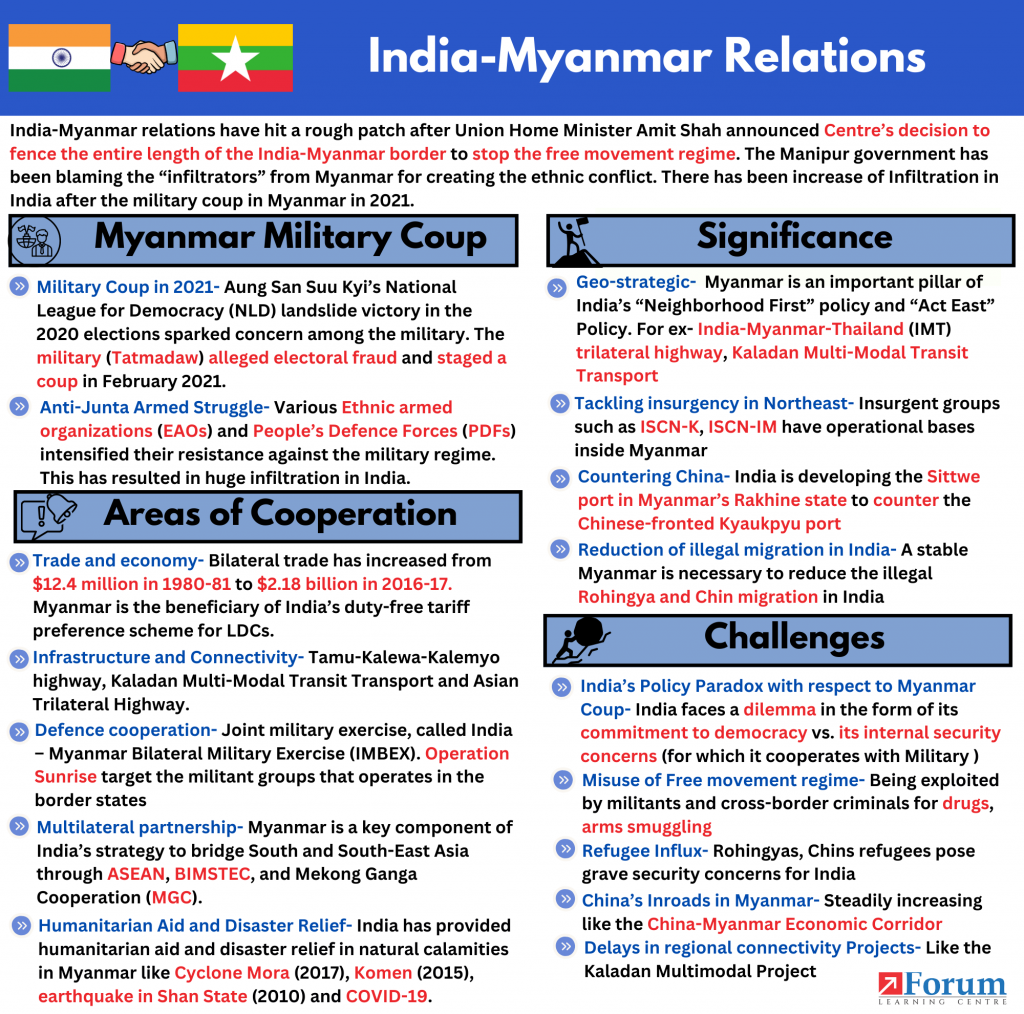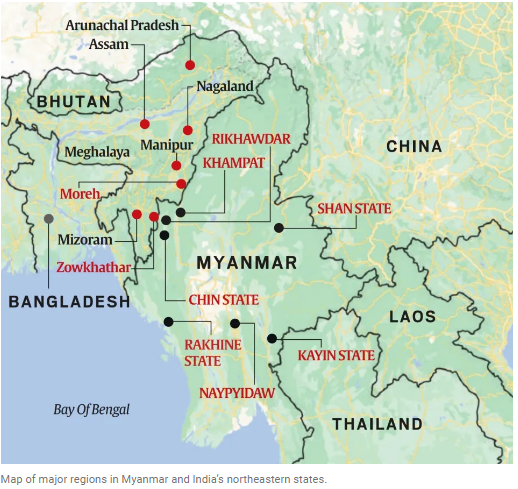ForumIAS announcing GS Foundation Program for UPSC CSE 2025-26 from 19 April. Click Here for more information.
India-Myanmar relations have hit a rough patch after Union Home Minister Amit Shah announced Centre’s decision to fence the entire length of the India-Myanmar border to stop the free movement regime.
The centre’s decision to fence the border has come in the wake of ongoing ethnic clashes in Manipur. The Manipur government has been blaming the “infiltrators” from Myanmar for creating the ethnic conflict. There has been increase of Infiltration in India after the military coup in Myanmar in 2021. India-Myanmar Relations Amid Myanmar Civil War

What is The Ongoing Crisis in Myanmar which has Led to Increase in Infiltrations in India?
Brief History of Political Unrest in Myanmar
| Parliamentary Democracy Phase | Myanmar (Burma) gained independence from British rule in 1948. The Country established a democracy based on the parliamentary system of Government. |
| First Phase of Military Rule | In 1962, General Ne Win staged a coup d’état, establishing a military dictatorship. The Burma Socialist Programme Party (BSPP) became the country’s sole political party. |
| Phase of Political Conflict within the military | In 1988, General Saw Maung seized control of the government, overthrowing the BSPP due to widespread economic decline and corruption. However, the military continued to rule under the State Peace and Development Council (SPDC). |
| Phase of Democratic Transition | In 2010, the SPDC held elections, paving the way for a quasi-civilian government. Aung San Suu Kyi’s National League for Democracy (NLD) won the 2015 elections. |
Current Military Coup and the Civilian Armed struggle
| Military Coup in 2021 | Aung San Suu Kyi’s National League for Democracy (NLD) landslide victory in the 2020 elections sparked concern among the military. The military (Tatmadaw) alleged electoral fraud and staged a coup in February 2021. Aung San Suu Kyi and other leaders were detained, sparking widespread protests and a violent military crackdown. |
| Anti-Junta Armed Struggle | Various Ethnic armed organizations (EAOs) and People’s Defence Forces (PDFs) intensified their resistance against the military regime, resulting in escalating conflicts across the country. |
Massive Influx of Refugees in India- The ongoing armed struggle between the military Junta and the People’s Defence forces in the Chin region, Sagaing region have led to massive influx of refugees in India, especially in Mizoram and Manipur. This influx of refugees in India has emerged as a major bone of contention between India and Myanmar, as these have been linked to violent ethnic clashes, drug trafficking and smuggling.

India’s stand on the Conflict- As Myanmar marked three years of military coup, India has called for complete cessation of violence in the country and its transition towards inclusive federal democracy.
What is the Historical Background of the India-Myanmar Relations?
India and Myanmar have a long history of cultural, religious, and trade links that date back to ancient times. As the land of Lord Buddha, India is a country of pilgrimage for the people of Myanmar.
| British Era | Both India and Myanmar were part of British India during colonial rule until 1935. |
| Post Independence | After independence, India and Myanmar established diplomatic relations and maintained close ties. India and Myanmar signed a Treaty of Friendship in 1951. |
| 2002 | Indian Consulate in Mandalay was reopened, and the Consulate of Myanmar was set up in Kolkata. |
| 2014 | Myanmar became part of India’s “Neighbourhood First” policy and its “Act East” policy. |
What is the Significance of Myanmar for India?
1. Geo-strategic- Myanmar is India’s gateway to South-East Asia and development of North-Eastern India. Myanmar is an important pillar of India’s “Neighborhood First” policy and “Act East” Policy. For ex- Development of India-Myanmar-Thailand (IMT) trilateral highway, Kaladan Multi-Modal Transit Transport (KMMTT) corridor rely on Myanmar.
2. Tackling insurgency in Northeast- Insurgent groups such as ISCN-K, ISCN-IM have operational bases inside Myanmar. For Ex- Cooperation of Myanmar government in controlling Naga insurgency.
3. Countering China- Myanmar is crucial for India to counter its growing influence in the South-East Asian region. For ex- India is developing the Sittwe port in Myanmar’s Rakhine state to counter the Chinese-fronted Kyaukpyu port.
4. Reduction of illegal migration in India- A stable Myanmar is necessary to reduce the illegal Rohingya and Chin migration in India.
5. Cultural ties- Buddhism which is the majoritarian religion in Myanmar has its roots in India, which has led to huge cultural similarities between India and Myanmar.
What are the Major Areas of Cooperation Between India and Myanmar?
1. Trade and economy- Bilateral trade between India-Myanmar has grown from $12.4 million in 1980-81 to $2.18 billion in 2016-17. Myanmar is the beneficiary of India’s duty-free tariff preference scheme for least-developed countries (LDCs). Indian companies such as Essar, GAIL, and ONGC Videsh Ltd. have invested in Myanmar’s energy sector.
2. Infrastructure and Connectivity- India-Myanmar relations has been bolstered by the key connectivity projects. India has invested deeply in the infrastructure projects in Myanmar.
a. India and Myanmar inaugurated the 250-kilometer Tamu-Kalewa-Kalemyo highway, popularly called the Indo-Myanmar Friendship Road, In 2001.
b. India is building the Kaladan Multi-Modal Transit Transport to link Kolkata to Sittwe in Myanmar and then from Myanmar’s Kaladan river to India’s north-east.
c. India, Myanmar, and Thailand are building the Asian Trilateral Highway, which will connect India to ASEAN.
3. Defence cooperation- India and Myanmar conduct a joint military exercise, called India – Myanmar Bilateral Military Exercise (IMBEX). Operation Sunrise between India-Myanmar armies jointly target the militant groups that operates in the border states.
4. Multilateral partnership- Myanmar is also a key component of India’s strategy to bridge South and South-East Asia through ASEAN, BIMSTEC, and Mekong Ganga Cooperation (MGC).
5. Education and research- India has developed Myanmar Institute of Information and Technology and Advanced Center for Agricultural Research and Education (ACARE) for conducting research on pulses and oilseeds.
6. Humanitarian Aid and Disaster Relief- India has provided humanitarian aid and disaster relief in natural calamities in Myanmar like Cyclone Mora (2017), Komen (2015), earthquake in Shan State (2010) and COVID-19.
What are the Challenges in India-Myanmar Relations?
1. India’s Policy Paradox with respect to Myanmar Coup- India faces a dilemma in the form of its commitment to democracy vs. its internal security concerns. On one hand, India has been engaging with the military junta to control insurgent groups operating along the India Myanmar border. On the other hand, India also favours the establishment of federal democracy in Myanmar.
2. Misuse of Free movement regime- The Free Movement Regime between India and Myanmar is being exploited by militants and cross-border criminals for the illegal transportation of weapons, contraband goods, and counterfeit Indian currency.
3. Refugee Influx- The ongoing violence and instability in Myanmar have led to a surge in the number of refugees fleeing to India. Over 54,100 Myanmar nationals have sought refuge in the Indian states of Arunachal Pradesh, Mizoram, Manipur, and Nagaland. These illegal migration of Rohingyas, Chins pose grave security concerns for India.
4. Northeast insurgency and Drug Menace– Myanmar-China border is the hotbed of local armed separatist groups operating in Myanmar soil and Indian groups, ranging from ULFA in Assam to the NSCN (IM) in Nagaland. Myanmar’s Golden Triangle region is a notorious hub for drug trafficking.
5. China’s Inroads in Myanmar- China has been steadily increasing its influence in Myanmar, investing heavily in infrastructure projects and expanding its economic footprint. For ex- The launch of China-Myanmar Economic Corridor.
6. Delays in regional connectivity Projects- The inordinate delays in the implementation of the connectivity projects like the Kaladan Multimodal Connectivity project have widened the trust deficit between India and Myanmar.
| Read More- Concerns Related to The India-Myanmar Border |
What Should be The Way Forward?
1. Support for democracy and human rights- The United Nations Special Rapporteur has reported an increase in India’s arms supply to the military since the coup. Arming the Tatmadaw (Myanmar Military) undermines India’s position on restoring democracy. India should continue to advocate for the restoration of democracy and respect for human rights in Myanmar like the release of political prisoners and ending the military junta’s crackdown on dissent.
2. Engagement with all stakeholders- India should use its influence to open channels of dialogue with and between the junta and the opposition, including armed ethnic groups.
3. Use of Regional Organisations for enhanced cooperation- India should collaborate closely with the ASEAN nations for a peace plan for Myanmar.
4. Enhanced Economic Engagement- India should continue to engage with Myanmar economically to promote sustainable development for the benefit of the people of Myanmar. The delayed connectivity projects like the Kaladan and Asian Trilateral Highways must be expedited at the earliest.
5. Closer Security Cooperation- India must closely collaborate with Myanmar in intelligence sharing and coordinated efforts to combat insurgencies and drug trafficking.
6. Solidarity with the People of Myanmar- Providing aid and service to those affected by the crisis will alleviate suffering and demonstrate India’s solidarity with the people of Myanmar.
| Read More- The Hindu UPSC Syllabus- GS 2- India and Neighbourhood Relations |







